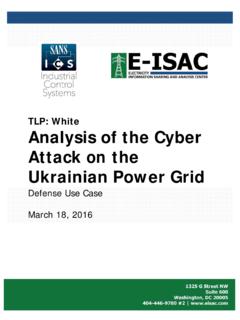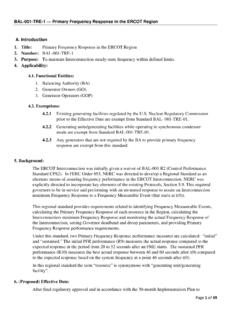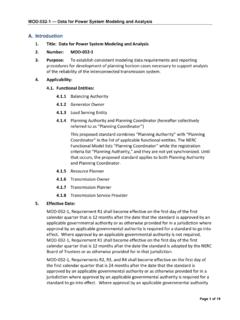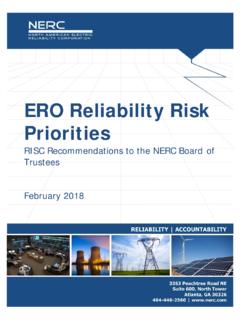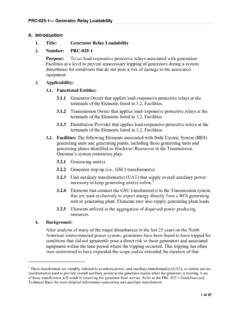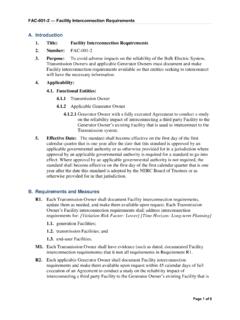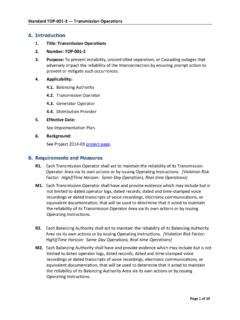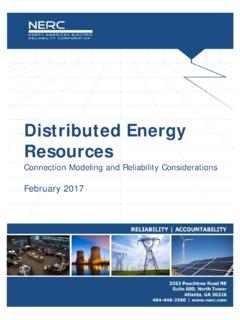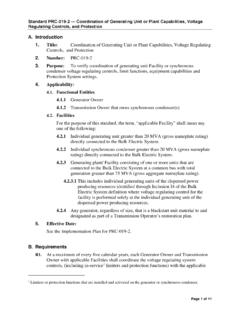Transcription of Fast Frequency Response Concepts and Bulk Power System ...
1 RELIABILITY | RESILIENCE | SECURITY NERC | Report Title | Report Date I Fast Frequency Response Concepts and Bulk Power System Reliability Needs NERC Inverter-Based Resource Performance Task Force (IRPTF) White Paper March 2020 NERC | White Paper: Fast Frequency Response | March 2020 ii Table of Contents Preface .. iii Executive Summary .. iv Background .. v Fundamentals of Frequency Response .. vi Chapter 1: Factors Determining Rate of Change of Frequency .. 1 Summary of Factors Affecting ROCOF .. 2 System Inertia .. 3 Size of Largest Credible Contingency .. 4 Speed of Frequency Response .. 5 Generator Dispatch Considerations .. 6 Chapter 2: Fast Frequency Response Concepts .. 7 Types of FFR Controls .. 9 Illustration of System Impacts of FFR .. 9 Chapter 3: Concept of Critical Inertia .. 12 Appendix A: References .. 14 Appendix B: Technology-Specific FFR Capabilities .. 15 Appendix C: Example Calculation of ROCOF.
2 21 Contributors .. 23 NERC | White Paper: Fast Frequency Response | March 2020 iii Preface Electricity is a key component of the fabric of modern society and the Electric Reliability Organization (ERO) Enterprise serves to strengthen that fabric. The vision for the ERO Enterprise, which is comprised of the North American Electric Reliability Corporation (NERC) and the six Regional Entities (REs), is a highly reliable and secure North American bulk Power System (BPS). Our mission is to assure the effective and efficient reduction of risks to the reliability and security of the grid. Reliability | Resilience | Security Because nearly 400 million citizens in North America are counting on us The North American BPS is divided into six RE boundaries as shown in the map and corresponding table below. The multicolored area denotes overlap as some load-serving entities participate in one Region while associated Transmission Owners/Operators participate in another.
3 MRO Midwest Reliability Organization NPCC Northeast Power Coordinating Council RF ReliabilityFirst SERC SERC Reliability Corporation Texas RE Texas Reliability Entity WECC Western Electricity Coordinating Council NERC | White Paper: Fast Frequency Response | March 2020 iv Executive Summary As the BPS continues to transition towards higher instantaneous penetrations1 of inverter-based resources, System synchronous inertia will decrease. Smaller interconnections in North America, namely the Texas and Quebec Interconnections, will be affected by this transition given their lower level of interconnection-wide synchronous inertia, and that these Interconnections are taking prudent steps2 to ensure that Frequency does not reach underfrequency load shedding (UFLS) levels for large unplanned losses of generation. The high initial rate of change of Frequency (ROCOF) caused by decreasing System inertia in an interconnection drives the need for faster energy injection to arrest declining Frequency .
4 This type of fast-acting Response to changing Frequency is considered fast Frequency Response (FFR), and FFR is increasingly recognized to be an essential reliability service (ERS) for reliable operation of the BPS. Key System characteristics critical to Frequency stability that responsible entities should consider when developing measures in the face of increasing penetrations of BPS-c onnected inverter-based resources include the following (see Figure ): The size of the contingency ( , loss of generation or loss of imported Power from dc tie lines from other interconnections) Overall System inertia of synchronously connected machines, including generation and motor loads Speed of Response and magnitude of energy injection provided by generation in Response to the observed deviation in Frequency Speed of Response and magnitude of load tripping or load Response to the observed deviation in Frequency As ROCOF increases following a large contingency on the BPS, particularly during low System inertia operating conditions, the potential need for FFR may become crucial in some interconnections where Frequency stability may be a risk.
5 Different types of technologies3 can provide FFR, and a framework for establishing critical inertia conditions can be developed based on current System characteristics and existing Frequency Response capabilities. While Balancing Authorities (BAs) are the entities responsible for reliable Frequency control, Transmission Planners (TPs), Planning Coordinators (PCs), and Reliability Coordinators (RCs), and any entities responsible for reliable planning and operation of the interconnected BPS are encouraged to consider the aspects described in this paper. Generator Owners (GOs), Generator Operators (GOPs), and original equipment manufacturers of inverters should apply these principles for BPS reliability needs and stable Frequency control. Lastly, this white paper is intended to be a useful reference for industry to better understand FFR and as a foundational document for IEEE P28004 that is standardizing the performance of newly interconnecting inverter-based resources to the BPS.
6 Reviewing and harmonizing definitions of existing FFR market products or services is outside the scope of this paper. 1 The term instantaneous penetration of inverter-based resources refers to the percentage of instantaneous load served by inverter-based resources at any given time. 2 For example, identification of critical inertia levels, maximum inverter-based resource penetration levels given specific requirements and technical capabilities, development of new requirements for FFR, considerations for provisions for ensuring Frequency responsive reserve levels, additional load resource capabilities, and other tools. These are described throughout this white paper as various solutions to ensure reliable Frequency control of the BPS in the face of increasing inverter-based resources. 3 This paper provides information related to different types of FFR based on industry understanding of equipment capabilities available at the time of writing ( , early 2020); equipment capabilities and operator practices are likely to continue evolving.
7 4 Figure : Factors Affecting ROCOF and the Frequency Nadir NERC | White Paper: Fast Frequency Response | March 2020 v Background As the penetration of inverter-based resources increases across the BPS in North America, industry needs to be kept informed concerning key aspects of the changing resource mix and its impact on BPS reliability. Starting in 2012 and through ongoing studies,5 NERC has been evaluating BPS ERSs. One such ERS is the ability to maintain System Frequency during normal operation and immediately following contingency events, referred to as Frequency control. The 2012 NERC Frequency Response Initiative Report6 laid a foundation for Frequency control in North America and provides much of the background information leading to this white paper. Subsequent to that report, NERC issued a reliability guideline on primary Frequency control7 that further elaborated on these Concepts and provided clear directions on how to address possible deficiencies in primary Frequency control from some generating resources.
8 In February 2018, the Lawrence Berkeley National Laboratory issued a report8 detailing fundamental aspects of Frequency control requirements for reliable operation of the BPS. This work was funded by the Federal Energy Regulatory Commission (FERC); around this same time, FERC issued Order No. 842,9 revising its regulations for the provision of primary Frequency Response for newly interconnecting generating resources. The final rule amended the pro forma Large Generator Interconnection Agreement and Small Generator Interconnection Agreement to require that all new generating facilities install, maintain, and operate a functioning governor or equivalent controls as a precondition of interconnection. In particular, FERC Order No. 842 requires newly interconnecting resources to perform the following:10 Install, maintain, and operate equipment capable of providing primary Frequency Response Respond to Frequency excursion events measured at the plant point of measurement11 with a maximum deadband of Hz Adjust its output with a droop characteristic of no more than 5% based on nameplate capacity Provide sustained Frequency Response to Frequency deviations rather than inject active Power for a short period and then withdraw it12 Defining FFR was not included in FERC Order No.
9 842; however, the need for FFR is growing as grid dynamics get faster with increasing penetrations of inverter-based resources. At the time of writing, various FFR services have been introduced in Power systems around the world that are already experiencing high instantaneous penetrations of inverter-based resources. There are System characteristics and operational considerations critical to maintaining Frequency control and Frequency stability that responsible entities should adopt as the penetration of inverter-based resources continues to grow. This includes the interaction between System inertia, ROCOF, and the speed and magnitude of active Power Response to arrest and stabilize System Frequency . Different technologies can provide this 5 6 7 8 9 #.XRUCrs-osnU 10 Reserving primary Frequency responsive reserve ( , headroom ) is not required per FERC Order No.
10 842. TPs and PCs may require more responsive droop settings; however, those should be based on engineering studies demonstrating that more responsive Frequency control is needed. 11 This is the high-side of the generator substation transformer, according to FERC Order No. 827. This white paper aligns with FERC on the use of Point of Measurement rather than Point of Interconnection unless referencing a specific NERC Reliability Standard that uses Point of Interconnection. 12 Primary Frequency control relies on a sufficient amount of responsive resources that are able to arrest the changing Frequency and then maintain a new balance of generation and load. Without sufficient sustained primary Frequency Response , Frequency will continue to decline. While some resources can provide sustained fast Frequency Response , others cannot provide this service. Therefore, the different types of fast Frequency Response need to be separated and uniquely integrated to ensure a sufficient balance of sustained and non-sustained Response .
